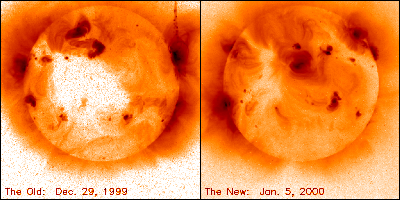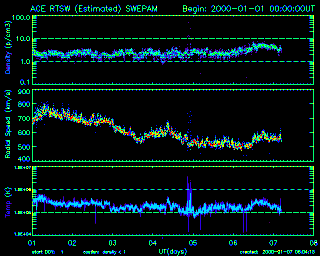Yohkoh returns from hibernation
Science Nugget: January 7, 2000
Introduction
The close of each year finds Yohkoh beginning an interval of several
days of low activity.
This coincides with the Japanese view of the New Year as a proper time for
a hiatus of human activity.
For Yohkoh this means downlinks only via NASA ground stations, and no
uplinks; also it means no quasi-real-time data.
Readers of these pages will recall that last year (last millenium!) we were
watching a huge coronal hole approaching the solar central meridian - would
this concievably result in a "disappearing solar wind" again?
Yohkoh's alive and well
First, since this is a memorable nugget (Yohkoh survived Y2K,
although many of the ground-based systems were a bit goofy), let us
confirm that the images are still beautiful:

The new year's image (on the right) shows that the telescope and its
complicated data processing all continue to work well.
Actually this somewhat conceals the truth, because in fact the Yohkoh
project did suffer from a great deal of Y2K software hassle, but
fortunately not in anything critical.
In the "old" image on the left, one can see the spectacular coronal
hole massively (or at least hugely) occupying disk center.
The solar wind has a healthily high pressure
In
last week's nugget we speculated that this large equatorial coronal
hole might turn the solar wind off again, as in the case described in
that nugget.
It only took a few days (at 700 km/s, actually only two and a half days)
for the sun to dispel this idea.
Below is a plot obtained from the on-line data provided
by the
ACE spacecraft:

where the red line shows the solar-wind speed surging almost to 800 km/s
on the first day of the millenium.
Our big coronal hole has emitted a high-speed stream, as is typical,
and this is not a case like the remarkable
case of May 6, 1999 at all.
So, a modest New Year's lesson from this might be... "Look before you leap"
into scientific speculation.
We still don't know much about the solar origins of the mysteriously
disappearing solar wind.
But if we do learn something, you will be the first to hear!
7-January-2000
H. Hudson (hudson@isass1.solar.isas.ac.jp)


